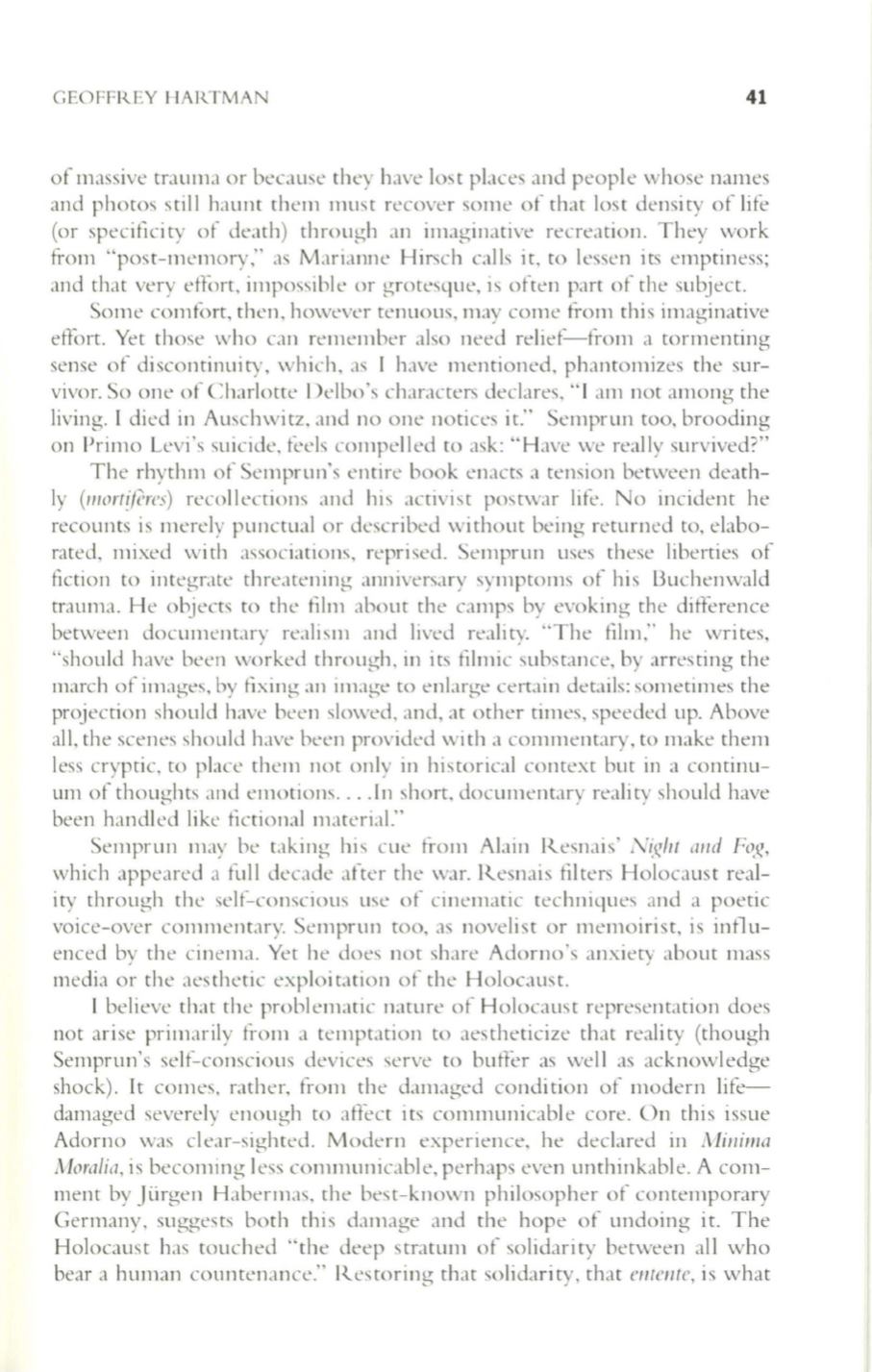
GEOFFR.EY HARTMAN
41
of massive trauma or because they have lost places and people whose names
and photos still haunt them must recover some of that lost density of life
(or specificity of deJth) through an imaginative recreJtion. They work
from "post-memory," JS MJriJnne Hirsch calls it, to lessen its emptiness;
and that very effort, impossible or grotesque, is often part of the subject.
Some comfort, then, however tenuous, mJY come from this imaginative
effort. Yet those who can remember also need relief-from a tormenting
sense of discontinuity, which, as I have mentioned, phJntomizes the sur–
vivor. So one of Charlotte Delbo 's chJracters declares, "I am not among the
living. I died in Auschwi tz, and no one notices it." Semprun too, brooding
on Primo Levi's suicide, feels compelled to ask: "Have we really survived?"
The rhythm of Semprun's entire book enacts a tension between death–
ly
(lI/orl!fCrcs)
recollections and his activist postwar life. No incident he
recounts is merely punctual or described without being returned to, elabo–
rated, mixed wi th associations, reprised. Semprun uses these liberties of
fiction to integrate threatening Jnniversary symptoms of his l3uchenwald
trauma. He objects to the film about the camps by evoking the difference
between documentary realism and lived reality. "The film," he writes,
"should have been worked through, in its filmic substance, by arresting the
march of images, by fixing an image to enlarge certain details: sometimes the
projection should have been slowed, and, at other times, speeded up. Above
all, the scenes should haw been provided with a commentary, to mJke them
less cryptic, to place theln not only in historical context but in a continu–
um of thoughts and emotions .... 1n short, documentary reali ty should have
been handled like fictional material."
Semprun may be taking his cue fi-om Alain
I~esnais'
N((!h/ and Fo,(!,
which appeared a full decade after the war. R.esnais filters Holocaust real–
ity through the self-conscious use of cinematic techniques and a poetic
voice-over commelltary. Semprun too, as novelist or memoirist, is influ–
enced by the cinema. Yet he does not share Adorno 's anxiety about mass
media or the aesthetic exploi tation of the Holocaust.
I believe that the problematic nature of Holocaust representation does
not arise primarily h-om a temptation to aestheticize that reality (though
Semprun's self-conscious devices serve to bufler as well as acknowledge
shock). It comes, rather, h-om the damaged condition of modern life–
damaged severely enough to affect its communicable core. On this issue
Adorno was clear-sighted. Modern experience, he declared in
Millill/a
Moralia,
is becoming less communicable, perhaps even unthinkable. A com–
ment by Jurgen Habermas, the best-known philosopher of contemporary
Germany, suggests both this damage and the hope of undoing it. The
Holocaust has touched "the deep stratum of solidarity between all who
bear a human countenance." R.estoring that solidarity, that
CII/Clllc,
is what


